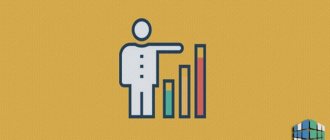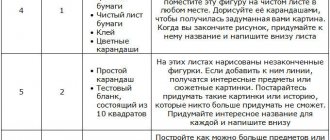Humanity thinks differently, which is why people are divided into artists, scientists, and athletes. Among the different types of human thinking, divergent thinking is distinguished, characterized by the speed and breadth of the process. It can be diagnosed in childhood, but it can develop in an adult.
Divergence is distinguished by non-standard solutions
The definition of a person’s thinking is based on its psychological component. This is a process of reflecting reality, as well as the ability to solve assigned problems. It is human nature to try to connect several phenomena together to obtain some picture of the world. The direction of thoughts depends on the skills of the individual, acquired by innate talent or trained for many years.
Basic types of thinking
The main types of thought processes include the following:
- Visually effective. The point is to start acting based on the situation. A person sees a problem, his task is to choose the appropriate tool to solve it;
- Visual-figurative. Inherent in artists, it begins with preschool children, when they perceive the world as a combination of images. The essence of this type is to better characterize a certain object or situation;
- Abstract. It is called verbal-logical thinking, it is based on a certain judgment, based on existing concepts about an object or phenomenon;
- Theoretical. An object is learned by applying rules, laws, and patterns to it. People with a theoretical line of thinking are often referred to as “intellectual economy,” since it is thanks to them that new discoveries are made, or at least the curtains of future discoveries are lifted;
- Practical. In contrast to the thought base of the theoretical direction, practical means action on the subject. Although it is often based on the theoretical, which should be proven by the example of a practical operation;
- Analytical. Analysts by nature are planners. They solve a certain problem step by step, based on existing facts;
- Intuitive. Unlike the previous type, intuition is alien to planning; it often acts as the subconscious commands and gets positive results;
- Creative (productive, reproductive). A type of thinking aimed at obtaining new knowledge. At the same time, the reproductive creative flow of thoughts is based on known facts. Productive – reveals the creative potential of the individual. This contributes to the accelerated acquisition of new knowledge for independent direction in the right direction.
Divergent thinking can offer unexpected ideas
Note! In psychology, divergence is an integral part of creative thinking, providing an individual with productive thought processes.
Structure
The ability to approach tasks and issues in a non-standard way is based on a group of features that make up the structure of the named method of activity. They can be defined as follows.
Objects
Certain objects that are used for further mental manipulation of them to achieve certain goals. These are not always things in the material sense of the word. It may well be that we are talking about extremely large structures that cannot be “identified in nature.” Road, house, planet. Also concepts at the intersection of the material and the abstract: society, etc. Or even ideal, intangible entities. The latter is especially typical for philosophical and scientific knowledge: life, death, love, freedom, the universe, matter, and other categories that do not have material expression.
Approaches
Actually, methodology. A list of methods that are used to operate on objects. Their systematization, analysis, applied use. The methodology is most clearly visible when assessing material, transformative human activity. For example, in the work of an inventor, mechanical engineer, etc.
If the convergent approach presupposes a certain academicism and even stereotypes, action according to a specific algorithm, divergent thinking requires a creative rethinking of given standards. New principles of object manipulation. To exaggerate: a cook with a convergent approach strictly follows the technological map and recipe and does not deviate one iota from them. With non-linear - tries to modify the recipe in order to achieve greater effect, improve taste, reduce cost without compromising quality, speed up the cooking process. In a word - optimize work and achieve better results.
Ideas
The ideas are based on a specific concept based on approximate ways of influencing objects, their combinations, relationships. This is an integral component.
If compared with the structure of the convergent paradigm, everything is simpler; a person using this method has more freedom to express himself and search for non-trivial ways of acting. The linear style has a more rigid structure and has frames:
- objects;
- methods;
- ideas;
- strictly defined algorithms, templates (they can be combined, but you cannot deviate from them);
- signs of objects;
- determination of their functions.
The definition of a divergent type of thinking initially presupposes not a logical, and certainly not a purely mechanical, but a creative approach. Since the structure gives more freedom, it is much more difficult for a person to take advantage of such wide opportunities in the initial stages. Divergent thinking needs to be learned. This is a practical group of skills. However, oddly enough, this method is much more effective if you need to solve problems that do not require a single approach.
According to theoretical and practical research, the greatest efficiency is achieved when it is possible to switch between different paradigms or use them in parallel.
Divergent thinking in psychology
Logical thinking - what is it and how to develop it in an adult and a child
Divergent thinking is part of the creative direction of a person's thought process. Its features are the search and receipt of many options for solving a given problem. Originality, speed, flexibility - this is divergent thinking. It is noteworthy that it can be developed in the younger generation and trained in the older generation. This way of thinking is said to mean that a person “goes in different directions.” By going through various options for solving a certain problem, a divergent is able to get a very unexpected outcome, although, of course, it is correct.
People can belong to different groups according to their way of thinking. Some have a creative mind, others are analytical.
They often believe that they are superior to each other in their way of thinking. This is wrong because it is impossible to determine which of them is better. But you can combine different types of thinking: train an analytical mind for a creative person and vice versa.
Often this memory training takes place through brainstorming methods, memory cards, and associations. The listed tools are suitable for developing divergent thinking in a person.
History of the concept
The term “Divergent Thinking” was first coined by Joy Gilford, an American psychologist who researched the human mind and intelligence. Guilford tried to build a model of intelligence that was multidimensional and included 3 dimensions (content, operations, results of thinking), which in turn were divided into variables. Convergent and divergent thinking were, according to his model, variables of operations, that is, one of the dimensions of intelligence.
By proposing two new types of thinking, Guilford moved away from the classical division into inductive (solving problems by deriving a general rule based on particular observations) and deductive (logical) thinking.
The development of Guilford's theory was continued by other psychologists: Taylor, Torrance, Grubber. They more clearly formed the very concept of divergence, established criteria for its identification, and established that this type of thinking allows a person to create non-standard ideas, hypotheses, classify and group the information received.
Diagnosis of divergent thinking
Art therapy for preschool children - what is it?
Usually a person is more developed in one direction of thinking, distinguished by a certain set of characteristics.
The combination of such qualities as lightness, flexibility, speed of thinking, and a number of other elements in psychology is divergence. It can be diagnosed from an early age.
Divergent thinking is identified from childhood
This is interesting
Here is a simple creativity test, which was invented by the father of the concept of “Divergent Thinking”, Joy Gilford: In 3 minutes you need to come up with as many options for using paper clips as possible; the ideas you come up with can be briefly written down. Then count how many options you have:
- Less than 10 – the level of creativity is below average;
- 10 – 12 – average level;
- 12-20 – good level;
- More than 20 – high level of creativity.
Is it possible to measure divergent thinking?
Divergent thinking can be determined, measured, assessed through diagnostics according to J. Guilford and testing by E. Torrance. The first method is designed to assess several important parameters of a creative way of thinking: originality, semantics, adaptability and spontaneity. The diagnosis consists of 14 so-called subtests, the results of which determine the level of development and activity of the divergent direction.
Volitional personality traits - what is it in psychology, their formation
An example of a Guilford diagnosis is a task that determines the ease of word use by a supposed divergent: over a certain period of time it is necessary to compose the largest possible number of words with a certain letter (for example, “d”). This also includes diagnosing attentiveness: finding a given object among many objects. Mr. Guilford also introduced a task during which the subject must make a drawing from geometric shapes.
Note! J. Guilford treated the diagnosis of divergence with great variety, but his tests are not suitable for children. Therefore, this diagnostic is not widely used among specialists due to the complexity of the tests.
Torrance testing offers a simple option for determining the divergence of a person of any age, starting from preschool. The test consists of a dozen abstract figures; the task itself asks the test taker to complete them into full-fledged images, supporting them with a name. During testing, attention is paid to 4 elements:
- Ease (determined by the speed of completing the task);
- Flexibility (switching between tasks);
- Originality;
- Elaboration, precision of the idea.
In addition to creative testing, E. Torrance has proposed verbal and audio tests, but these are in much less demand.
Divergence (divergent) is...
"Divergence" is translated from the Latin "divergere" as " divergence ". Consequently, divergence is the process of divergence of any objects.
The objects to which this concept is applicable may be different, it all depends on the field of application, but in everyday life the term “divergence” is not used.
Now let’s talk about why your favorite movie is called “Divergent” . The plot of the film is that in a totalitarian world, where people are divided into factions according to certain characteristics, individuals appear who do not fit into any of the outlined niches.
Divergents are rebels who do not accept the status quo. Their life position diverges (is in divergence) from the generally accepted one.
An aggressive divergent is dangerous to society. To preserve order, such a person must be eliminated (isolated, destroyed). The film is about the ups and downs of the confrontation between the divergent and society.
The opposite in meaning to the word “divergence” is the word “convergence” (convergence) . This term and its use are described in detail in another article on our blog.
The application of the concept of “divergence” in various fields has its own characteristics.
So, for example, in mathematics, divergence is an operator that characterizes the divergence of the incoming and outgoing flow when differentiating a vector field. For those who want to learn in detail about the features of divergence in higher mathematics, I provide a link for viewing.
In this article we will look at the more common use of the term in different fields.
How to develop divergent thinking
Modern society requires a person to have a creative approach and quickly and effectively overcome difficult situations. Therefore, it is so important to consider the development of a divergent solution, even if the individual believes that this is alien to him.
It is necessary to develop different lines of thought
Methods for developing divergence include:
- Movement of thoughts. A certain object is taken, for example, a telephone, and everything that can be done with it is written down on a piece of paper. It is important to give free rein to non-standard options;
- Questions. Helps to find a solution where there seems to be none. You need to take a certain problem and ask as many questions as possible. The solution will sooner or later come from an unexpected direction;
- Associations. Associative memory is one of the most interesting phenomena, so it is important to develop this area. Write any word on a piece of paper, draw several “rays” from it and describe associative chains.
Joy fuels your imagination
There is such a concept from the famous psychologist J. Nina Lieberman called the “Joy Manifesto”. It turns out that in order to think creatively, some other conditions are necessary, such as:
- Joy
- Good mood
- Optimism
- A good relationship
- Sufficient rest
- Life without stress and tension
- There shouldn't be any anxiety
- Inner well-being
In a word, a person must be in harmony with himself, then he generates new ideas and he can go in different ways, knowing for sure that even if he “falls, he will rise easily” and go a different way! And this is all due to divergent thinking... this article is about that!
Join us on the Yandex.Zen channel
What is convergent thinking
Convergent thinking is a branch of logical thinking in psychology; it is deduction and induction. Given that divergents are taught to think diversified, convergence is based on a linear way of thinking, i.e. in one direction.
Divergent thinking is broader than convergent thinking. On the one hand, the linearity of the converger provides it with a short path to solving the problem, and the most reliable one at that. Divergents are able to find dozens of ways to solve a problem, and sometimes get something unique and new.
Speed, flexibility, innovative thinking - all these are characteristics of a divergent. A modern person needs to develop these qualities in himself in order to increase the efficiency of work and life in general. It is very important that the methods of training divergent thinking are simple; you only need desire and determination.
Planning for creativity is possible!
You may think that planning and creativity are two mutually exclusive concepts. But, having assessed all the pros and cons of divergent and convergent thinking, you will understand that they get along well together.
You can always find a time and place for both approaches, and the most effective project managers understand when and how to use them. Follow our guidelines and you'll be able to successfully complete projects while being flexible and embracing change and new ideas.
Want to experience a project management and collaboration solution that supports both divergent and convergent thinking? Sign up for a 14-day free trial of Wrike!











